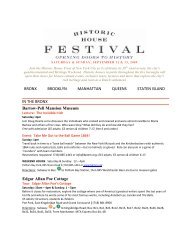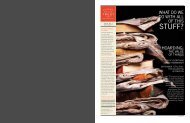Download PDF - The Historic House Trust of New York City
Download PDF - The Historic House Trust of New York City
Download PDF - The Historic House Trust of New York City
Create successful ePaper yourself
Turn your PDF publications into a flip-book with our unique Google optimized e-Paper software.
H I S T O R I C H O U S E T R U S T O F N E W Y O R K C I T Y<br />
H I S T O R I C H O U S E T R U S T O F N E W Y O R K C I T Y<br />
B r o n x<br />
—————————————<br />
Bartow-Pell Mansion<br />
Museum<br />
www.bpmm.com<br />
718-885-1461<br />
Edgar Allan Poe Cottage<br />
www.bronxhistoricalsociety.org<br />
718-881-8900<br />
Valentine-Varian <strong>House</strong><br />
www.bronxhistoricalsociety.org<br />
718-881-8900<br />
Van Cortlandt <strong>House</strong><br />
www.vancortlandhouse.org<br />
718-543-3344<br />
B r o o k ly n<br />
—————————————<br />
Lefferts <strong>Historic</strong> <strong>House</strong><br />
www.prospectpark.org<br />
718-789-2822<br />
Hendrick I. Lott <strong>House</strong><br />
www.lotthouse.org<br />
Old Stone <strong>House</strong><br />
www.theoldstonehouse.org<br />
718-768-3195<br />
Wyck<strong>of</strong>f Farmhouse<br />
Museum<br />
www.wyck<strong>of</strong>fassociation.org<br />
718-629-5400<br />
M a n h at ta n<br />
—————————————<br />
Dyckman Farmhouse<br />
Museum<br />
www.dyckmanfarmhouse.org<br />
212-304-9422<br />
Gracie Mansion<br />
www.nyc.gov/gracie<br />
212-570-4751<br />
Little Red Lighthouse<br />
212-304-2365<br />
Merchant’s <strong>House</strong><br />
Museum<br />
www.merchantshouse.org<br />
212-777-1089<br />
(continued page 9)<br />
Can We “Preserve” Change?<br />
Should We?<br />
By Jonathan Mellon, <strong>Historic</strong> <strong>House</strong> <strong>Trust</strong> Resident Engineer<br />
An 1840s Greek Revival style house in<br />
Savannah, GA altered in the post Civil<br />
War period to reflect prevailing architectural<br />
tastes <strong>of</strong> the time…an 1830s Federal style house<br />
in Brooklyn Heights with an entirely reworked façade<br />
from the Victorian period…Although the history<br />
<strong>of</strong> the United States is relatively a short one, the<br />
historic properties that have been preserved provide<br />
us with a timeline <strong>of</strong> the architectural styles that<br />
have dominated from one period to another; some<br />
lasted for decades, others for a fleeting few years.<br />
Since the beginning <strong>of</strong> the preservation movement<br />
in this country, one <strong>of</strong> the central questions<br />
that has been asked is what do we mean when we<br />
What is “authentic”? This image <strong>of</strong> the Van Cortlandt<br />
<strong>House</strong> Museum dining room c. 1970s represents a<br />
stylized recreation <strong>of</strong> the past.<br />
say a property will be preserved? Virtually every<br />
structure has seen some alterations over the years,<br />
from such small changes as the replacement <strong>of</strong><br />
a wooden shingle ro<strong>of</strong> with a slate one, to more<br />
prominent alterations such as the addition <strong>of</strong> the<br />
wraparound porch at Gracie Mansion.<br />
When a property is preserved, efforts have<br />
been made to have it reflect its period <strong>of</strong> significance;<br />
the time when it was occupied by an<br />
important individual or when an important event<br />
took place there. Yet honing in on a specific moment<br />
in the building’s history <strong>of</strong>ten leads to difficult<br />
decisions about the interior and exterior restoration,<br />
as well as the collection <strong>of</strong> objects that will be<br />
displayed. This issue has been thrust in to the everevolving<br />
national preservation discussion with the<br />
recent restoration <strong>of</strong> James and Dolly Madison’s<br />
Montpelier in Virginia.<br />
Beginning in 2001, the Montpelier Foundation<br />
began an exhaustive assessment <strong>of</strong> the property.<br />
<strong>The</strong>y opened up walls and floors to perform a<br />
thorough examination <strong>of</strong> the house’s physical<br />
evolution and critically scrutinized newly found<br />
architectural plans for the house. <strong>The</strong> house had<br />
been altered significantly by major additions and<br />
countless other changes by its most recent owners,<br />
the DuPonts. After the analysis, the Foundation<br />
and its partners reached the decision to restore<br />
Montpelier to the period <strong>of</strong> Madison’s presidency.<br />
<strong>The</strong> subsequent restoration work was a turning back<br />
<strong>of</strong> the clock—visitors today encounter a site that<br />
closely resembles Madison’s house <strong>of</strong> 200 years ago.<br />
While the course <strong>of</strong> action taken at Montpelier<br />
is certainly an understandable one, and an extremely<br />
well documented and executed one at that, it is<br />
also one that raises a host <strong>of</strong> important questions.<br />
<strong>The</strong> restoration <strong>of</strong> Montpelier did not just consist<br />
<strong>of</strong> repainting clapboards to their historic color or<br />
removing modern windows—it essentially removed<br />
much <strong>of</strong> the house itself. While these later additions<br />
certainly were not related to Madison’s experience<br />
in the house, they did reflect its evolution over the<br />
years, representing a parade <strong>of</strong> architectural styles<br />
and tastes.<br />
A similar issue, albeit on a much smaller scale,<br />
was encountered recently at one <strong>of</strong> our own houses<br />
with the restoration <strong>of</strong> the dining room at Van<br />
Cortlandt <strong>House</strong>. <strong>New</strong> <strong>York</strong> <strong>City</strong>’s first historic house<br />
museum, this house was home to the Van Cortlandt<br />
family for close to 140 years, during which it saw<br />
alterations to its interior as it passed from generation<br />
to generation. When it became a house museum in<br />
1896, it was restored, and has since seen a series<br />
<strong>of</strong> continued alterations that have sought to enhance<br />
and capitalize on the earlier restoration efforts.<br />
This project focused on the restoration<br />
<strong>of</strong> plaster and woodwork in the dining room, but it<br />
was expanded when structural problems with the<br />
fireplace became evident. What began as a relatively<br />
simple restoration project resulted in a series <strong>of</strong><br />
some surprising discoveries.<br />
Upon removal <strong>of</strong> plaster on one wall, a long<br />
since forgotten doorway was discovered, which may<br />
have led at one time to a summer kitchen. Adjacent<br />
to the door were remnants <strong>of</strong> the wood paneling that<br />
originally covered the whole wall. A number <strong>of</strong> layers<br />
<strong>of</strong> wallpaper also were uncovered on the wall, which,<br />
along with the doorway, had been preserved beneath<br />
the plaster.<br />
As was the case with Montpelier, the decision<br />
was made to restore the dining room to how it would<br />
have looked during its period <strong>of</strong> significance at<br />
the turn <strong>of</strong> the 19th century. <strong>The</strong> plan calls for the<br />
restoration <strong>of</strong> the doorway, for the wall to be covered<br />
with wood paneling, and for the other walls to be<br />
covered in early 19th century reproduction wallpaper.<br />
Detail <strong>of</strong> the outermost<br />
wallpaper, which dates<br />
to c. 1824. <strong>The</strong> earliest<br />
layer dates to c. 1750.<br />
<strong>The</strong> Van Cortlandt<br />
<strong>House</strong> staff consulted<br />
Gregory Herringshaw<br />
<strong>of</strong> the Cooper-Hewitt<br />
National Design Museum<br />
and Wendy Weeks <strong>of</strong> the<br />
American Paper-Staining<br />
Manufactory and Exhibit<br />
at the Farmer’s Museum<br />
in Cooperstown. Mr.<br />
Herringshaw identified<br />
the outermost paper<br />
as the work <strong>of</strong> the<br />
Parisian wallpaper<br />
firm, Jacquemart &<br />
Benard. Further research<br />
was completed by the<br />
Northeast Document<br />
Conservation Center, who<br />
separated and cleaned<br />
a sample <strong>of</strong> the surviving<br />
layers <strong>of</strong> wallpaper.<br />
Together, the layers <strong>of</strong><br />
paper span the period<br />
<strong>of</strong> historic significance<br />
at the museum.<br />
As part <strong>of</strong> the project, however, the original layers<br />
<strong>of</strong> wallpaper that were uncovered will be preserved<br />
beneath the new wallpaper as a record <strong>of</strong> the house’s<br />
evolution.<br />
Still, as was the case with Montpelier, the<br />
decision to restore the room to a particular period<br />
ultimately results in hiding the marks <strong>of</strong> change over<br />
the centuries from the visiting public. At Montpelier<br />
the extreme decision to remove later alterations<br />
has forever removed the opportunity for visitors to<br />
observe and engage with the changes that shaped<br />
the house over the years. At Van Cortlandt, with the<br />
original wallpaper safely documented and preserved<br />
underneath the new layer, that opportunity still<br />
exists for future museum curators to expose and in<br />
turn shed light on changing popular tastes <strong>of</strong> the<br />
<strong>New</strong> <strong>York</strong> elite.<br />
But what if we had complicated this project by<br />
not simply restoring the room to present a recreation<br />
<strong>of</strong> the past? What if we had simply left the blockedup<br />
doorway, adjacent woodwork, and layers <strong>of</strong><br />
wallpaper exposed? This approach has become a<br />
hot topic <strong>of</strong> debate in the preservation community.<br />
Would it disrupt visitors’ experience <strong>of</strong> a historic<br />
site, or challenge them to think critically about<br />
change over time? <strong>The</strong>se are important issues that<br />
remain to be resolved by preservationists in the<br />
coming years.<br />
M a n h at ta n (cont’d)<br />
—————————————<br />
Morris-Jumel Mansion<br />
Museum<br />
www.morrisjumel.org<br />
212-923-8008<br />
Swedish Cottage<br />
Marionette <strong>The</strong>atre<br />
www.cityparksfoundation.org<br />
212-988-9093<br />
Q u e e n s<br />
—————————————<br />
Bowne <strong>House</strong><br />
www.bownehouse.org<br />
718-359-0528<br />
King Manor Museum<br />
www.kingmanor.org<br />
718-206-0545<br />
Kingsland Homestead<br />
www.queenshistorical<br />
society.org<br />
718-939-0647<br />
Lewis H. Latimer <strong>House</strong><br />
718-961-8585<br />
Queens County Farm<br />
Museum<br />
www.queensfarm.org<br />
718-347-FARM<br />
S tat e n I s l a n d<br />
—————————————<br />
Alice Austen <strong>House</strong><br />
www.aliceausten.org<br />
718-816-4506<br />
Conference <strong>House</strong><br />
www.conferencehouse.org<br />
718-984-6046<br />
<strong>Historic</strong> Richmond Town<br />
www.historicrichmondtown.org<br />
718-351-1611<br />
Seguine Mansion<br />
718-667-6042<br />
For more information on these<br />
sites please visit our website<br />
at www.historichousetrust.org<br />
8<br />
winter 2010<br />
winter 2010 9




